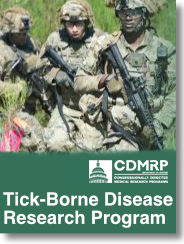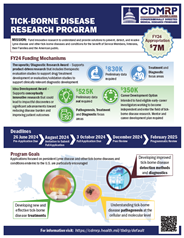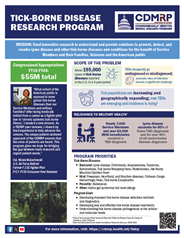Tick-Borne Disease
Vision – Eliminate the health burden of tick-borne diseases

» Click on Image to View Program Annual Report

» Click on Image to View Strategic Plan

» Click on Image to View Program Overview

» Click on Image to View Program Summary Sheet
There are currently at least 18 known tick-borne infectious pathogens, with 20 known conditions and 13 illnesses resulting from tick bites.1 As tick populations continue to grow and ticks expand geographically, yearly cases of Lyme disease and other tick-borne diseases, including spotted fever rickettsiosis, anaplasmosis, and ehrlichiosis, have been increasing steadily for years in the United States, with tens of thousands of people diagnosed annually and more likely undiagnosed.
Much remains to be determined regarding tick-borne disease pathogenesis, including host-pathogen interactions and the human immune response to these pathogens. There is a need for better disease prevention in terms of controlling the natural cycle of disease and protecting people from tick bites by various means. For people who are bitten, having methods of direct detection of tick-borne pathogens is critical in guiding treatment, and more must be learned about the cause of persistent symptoms in Lyme disease and other tick-borne illnesses in order to establish the best treatments.
The Tick-Borne Disease Research Program (TBDRP) was established in fiscal year 2016 (FY16) to support innovative and impactful research that addresses these fundamental issues and gaps in tick-borne diseases. Hallmarks of TBDRP funding include the involvement of Lyme and tick-borne disease advocates in our two-tier review process, as well as the mission of addressing tick-borne diseases as a threat to military forces and their dependents.
Resources for Investigators
Funding Opportunity FAQ Document
Reference:
1. Tick-Borne Disease Working Group, 2018 Report to Congress, Chapter 1, p. 5 (https://www.hhs.gov/sites/default/files/tbdwg-report-to-congress-2018.pdf).
![]()
Congressional Appropriations
- $48 million
FY16-23 - $7 million
FY24

Funding
Summary
- 55 Awards in FY16-23
- Recent Applications Recommended for Funding
- TBDRP FY16-23 Portfolio Pie Charts

Programmatic
Panels

Peer Review Participants
Last updated Wednesday, March 19, 2025














